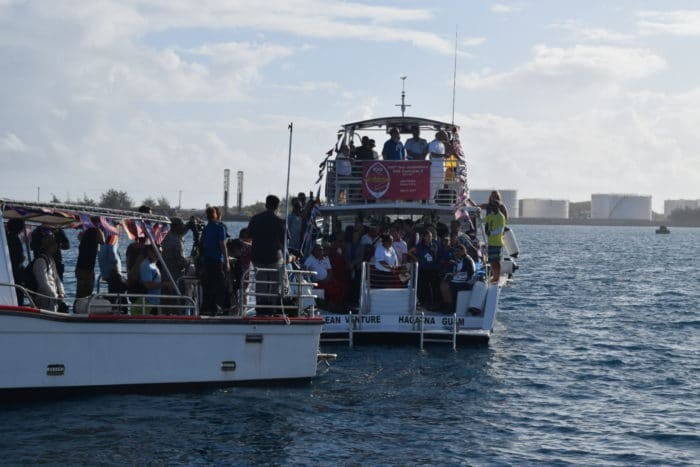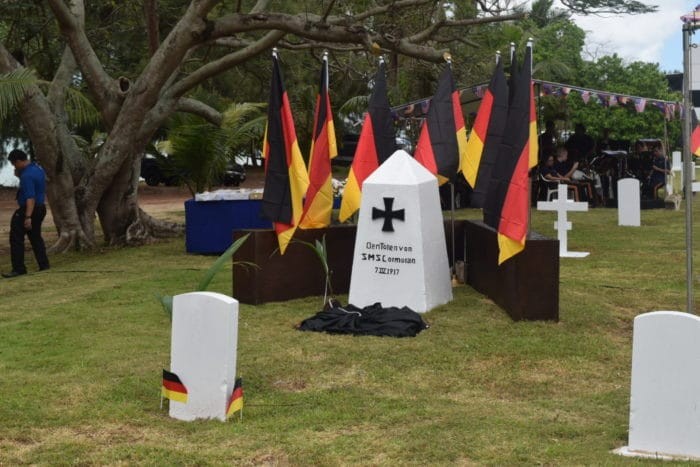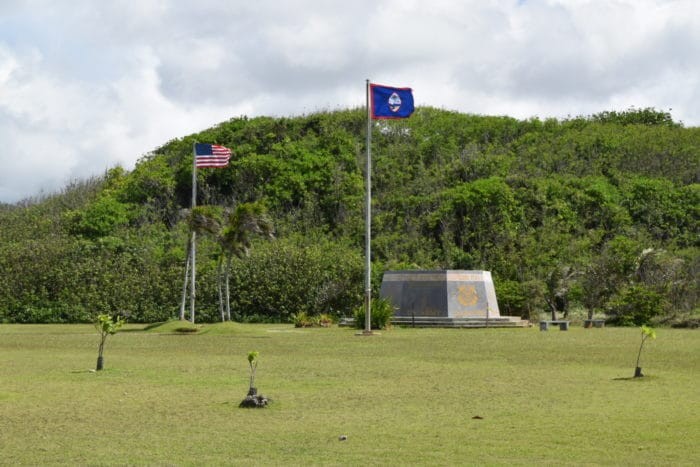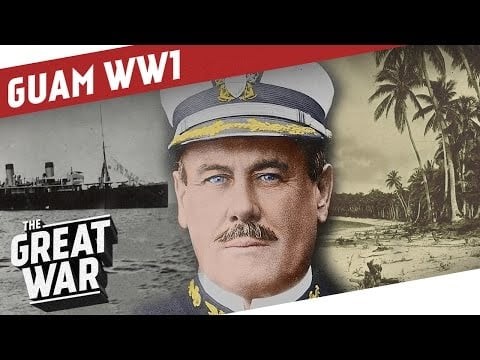I love diving shipwrecks, to me, they show the precarious balance between men and nature. Shortly after a ship goes down, mother nature takes over. The ship becomes a part of nature, becoming home to marine life and slowly being covered with coral or marine growth. The ship is a time capsule of when it went down. While I have nothing against a ship that was sunk for the purpose of creating a reef, I favor those that sank while still in service.

On April 7th, 2017, There was a dual ceremony to remember the 100 year anniversary of the sinking of the German warship SMS Cormoran II. The first was a placing of a reef on the ship by divers. Early in the morning, a small flotilla of vessels traveled to the site where the ship rests 80 to 110 feet below. At 8:03 am, one hundred years to the minute that the Captain gave the command to destroy her, a ship bell was ranged and a dedication began honoring the ship laying below and her crew. The events that lead up to her demise was explained as was the actions of those involved. There were speeches by a US Senator, the German Charge d’affaires from the nearest embassy, local representatives and members of the families of surviving crew members. The event ended with divers taking a wreath to the ship and returning to the surface.
Later in the day, a commemoration was held at the US Naval Cemetery were those who died that day were buried. The impact the officers and crew had during their time on the island and stories of those who returned after the war were told. Families who trace back to the crew of the ship laid flowers on the graves. Local Chamorro cultural groups provided honors in accordance with their culture. The Guam Visitors Bureau organized the event that also included presentations about the events a hundred years ago and the impact the ship’s arrival had on Guam.

Prewar Confinement
As the video mentions the SMS Cormoran had been in Guam since December 14th, 1914. While Governor Maxwell was in charge, the crew of the SMS Cormoran had very little freedom. While the video said the governor had a nervous breakdown, other records show that the other officers on Guam relieved him of command after a long pattern of irrational behavior. Much of that aimed at the German crew. After his replacement, the crew was given increasing more freedom with many moving into homes on the island. The Germans became accepted into the society and made many friends both in the civilian and military populations. A number of crew members even married locals. One US Navy nurse married one of the officers from the German ship.
The declaration of war suddenly turned friends into enemies. Relationships were shattered and new families are torn apart. The SMS Cormoran was destroyed by the Captain and crew to keep it from being used against their homeland. In the process, seven lives were lost. Bodies of six of the seven were recovered and buried with military honors at the US Navy cemetery. A memorial was also erected honoring the ship itself. The US Naval Institute’s Naval History blog has an eyewitness account of the events of the day the SMS Cormoran was destroyed.
Then There Was WWII
The impact of WWI was not so great on Guam. There was no fighting on the island. The Japanese took control of much of the former German colonies, with Australia and New Zealand taking some.
Guam was attacked in the opening hours of WWII against the Americans. Within hours of the attack on Pearl Harbor, The Island of Guam was also attacked. The island had only a token military force and soon fell into Japanese hands.
There are a few points that do relate to the SMS Cormoran. During the war, American submarines patrol the waters near Guam looking for Japanese shipping. The US submarine Flying Fish observed some ships anchored in Apra Harbor on January 24, 1943. After waiting for a few days to catch the ships leaving port, the ship fired torpedoes into the harbor. Tokai Maru was one of the ships and she was damaged. A number of months later another submarine, the Snapper, also saw a couple of freighters in the harbor, after they waited a week, they also sent torpedoes into the harbor on August 27th. Again the Tokai Maru was hit but this time she sunk.
When she came to her final resting point, she was just a few feet away from the SMS Cormoran. Today the two ships are often dived on a single dive. It is said that this dive site is the only one in the world where a diver can touch ships from both World Wars at the same time.

One other interesting note is that the site where the Cormoran crew were initially held as prisoners of war is the same place that the American troops landed to retake Guam.
Diving the Cormoran and Tokai Maru
Diving the Cormoran and Tokai Maru makes for an exciting dive for advanced divers. The SMS Cormoran lays on her left (port) side in 120 feet of water. You can follow along the starboard side in about 80 feet of water. The bridge and superstructure are mostly in the range of advanced divers, while deep trained divers can see a bit more. Divers trained as both deep and wreck divers can penetrate portions of the ship. Two cargo loading doors near the bridge allow entry into the cargo bays. Being Nitrox or Tec trained adds some bottom time. Visibility is generally good with a 60 foot range being common, however, this can suffer if there is heavy port traffic.
Diving Guam
Guam is where America Starts it Day. The diving clientele is divided into a couple of niches. There is a strong market for discover dives from the Asian tourist that come here. It is the closest American destination to the Asian market, taking less than half the travel time as Hawaii. You will often see these groups at some of the shore dive sites around the island. The majority of the dive sites including the Cormoran are primarily dived by the locals and semi-locals. Service members and their families assigned to the two major Guam bases make up about a third of the islands population. Many of these people are active divers. Diving is inexpensive in Guam provided you have your own gear, dive buddy, DSMB, and dive computer. You can grab a tank or two from a local dive center and do a shore dive for just the cost of the refill. There are also daily boats you can join going out to a dive site at a reasonable fee. However, this is not resort diving. Nobody is going to hold your hand, carry your gear or set it up for you. This is a destination for divers to dive.
The local dive shops have told me the same thing when I asked them about getting dive tourist. They say that many divers just pass thru Guam on their way to Palau or Chuk. They suggest that divers take a few days, and relax in Guam and get in some dives before moving on the those other locations. If you don’t, you are missing some great diving.


